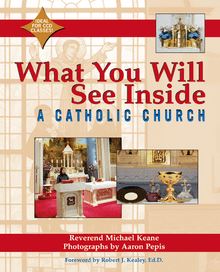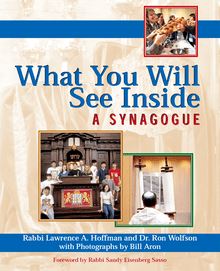-
 Univers
Univers
-
 Ebooks
Ebooks
-
 Livres audio
Livres audio
-
 Presse
Presse
-
 Podcasts
Podcasts
-
 BD
BD
-
 Documents
Documents
-
- Cours
- Révisions
- Ressources pédagogiques
- Sciences de l’éducation
- Manuels scolaires
- Langues
- Travaux de classe
- Annales de BEP
- Etudes supérieures
- Maternelle et primaire
- Fiches de lecture
- Orientation scolaire
- Méthodologie
- Corrigés de devoir
- Annales d’examens et concours
- Annales du bac
- Annales du brevet
- Rapports de stage
La lecture à portée de main
Vous pourrez modifier la taille du texte de cet ouvrage
Découvre YouScribe en t'inscrivant gratuitement
Je m'inscrisWhat You Will See Inside a Synagogue , livre ebook
Découvre YouScribe en t'inscrivant gratuitement
Je m'inscrisEn savoir plus
Vous pourrez modifier la taille du texte de cet ouvrage
En savoir plus

Description
A colorful, fun-to-read introduction that explains the ways and whys of
Jewish worship, faith, and religious life.
What You Will See Inside a Synagogue will:
- Satisfy kids’ curiosity about what goes on in synagogues attended by their friends, broadening awareness of other faiths at an important age when opinions and prejudices can first form.
- Provide Jewish children with a deeper understanding of the practices of their own religious tradition.
- Give children the opportunity to ask questions, making them more active participants.
Colorful full-page photographs set the scene for concise but informative descriptions of what is happening, the objects used, the clergy and laypeople who have specific roles, the spiritual intent of the believers, and more.
The What You Will See Inside… series is designed to show children ages 6–10 the Who, What, When, Where, Why, and How of traditional houses of worship, liturgical celebrations, and rituals of different world faiths, empowering them to respect and understand their own religious traditions—and those of their friends and neighbors.
Sujets
Informations
| Publié par | Turner Publishing Company |
| Date de parution | 17 janvier 2013 |
| Nombre de lectures | 0 |
| EAN13 | 9781594735028 |
| Langue | English |
| Poids de l'ouvrage | 1 Mo |
Informations légales : prix de location à la page 0,0450€. Cette information est donnée uniquement à titre indicatif conformément à la législation en vigueur.
Extrait
Thank you for purchasing this SkyLight Paths e-book!
Sign up for our e-newsletter to receive special offers and information on the latest new books and other great e-books from SkyLight Paths.
Sign Up Here
or visit us online to sign up at www.skylightpaths.com .
Looking for an inspirational speaker for an upcoming event, conference or retreat?
SkyLight Paths authors are available to speak and teach on a variety of topics that educate and inspire. For more information about our authors who are available to speak to your group, visit www.skylightpaths.com/page/category/SLP-SB . To book an event, contact the SkyLight Paths Speakers Bureau at publicity@skylightpaths.com or call us at (802) 457-4000.
Foreword
Shalom! For almost 2,000 years, the synagogue, like the home, has been the center of Jewish life.
Three Hebrew names for synagogue describe what goes on in it. We call the synagogue Beit Tefilah , a house of prayer. Here people gather to worship, sing praise to God, offer thanks, and ask for help. Wherever Jews gather together, there is a community of prayer. We don t need a special building to pray; we just need each other. Still, Jews have always constructed places to bring people together for prayer.
We call the synagogue Beit Midrash , a house of study. In every sanctuary is a book, the Torah. Jews are called the People of the Book. You will often find libraries in synagogues, and you will always find people, young and old, learning.
We call the synagogue Beit Keneset , a house of gathering. Actually, the word synagogue comes from two Greek words meaning bringing together. It is where people come during good times and sad times. They mark important moments in life with each other. They come to do good deeds to help others.
In the synagogue you will see people welcome a new child into the community. Here young boys and girls of thirteen become bar and bat mitzvah, accepting their responsibilities to the Jewish people. Often weddings take place in the synagogue as the bride and groom stand under a chuppah , a wedding canopy. People also come to remember those they love who have died.
There are many symbols you will see in the synagogue. They help remind us about God, about Torah, and about living a good life. The information you find in this book will help you feel welcome. Come in!
Rabbi Sandy Eisenberg Sasso, D.Min., author of God s Paintbrush, In God s Name , and Adam Eve s First Sunset: God s New Day
Shalom! Welcome!
S HALOM ! * is a greeting in Hebrew, a holy language for Jews. This book gives you some other Hebrew words for things that you may hear in synagogues. When you see this mark (*), look at the bottom of the page to see how the Hebrew word is pronounced.
Sometimes a synagogue is called a temple, or a shul ,* a word that reminds us of school, because synagogues are places for learning, not just praying. Learning is a very important part of Judaism.
Synagogues may be big or small, fancy or plain. No matter what they look like, however, all synagogues are places for learning, praying, and gathering together. People gather to celebrate happy times, to find comfort when they are sad, to give charity, and to do good deeds. In this book we focus mainly on the synagogues and services of the Conservative, Reconstructionist, and Reform movements in Judaism, the synagogues that you will see most in North America.
Everyone is welcome here, because Jews believe that every single person is made in God s image. That means that our goodness, our conscience, and our right to be treated with dignity make us like God. Synagogues are holy places, where everyone is welcome because everyone is holy-like God.
The most important room in a synagogue is its sanctuary, where we meet to pray. Mostly, this book shows you what is in the sanctuary. But sanctuaries are not just for things. They need people. So synagogues are for people. The Bible says, May those who enter be blessed. When you enter a synagogue, we pray that God blesses you.
Welcome to the synagogue!
Shalom: shah-LOHM
Shul: SHOOL
Who Are the Jewish People?
Jewish people are many different colors and from many different nations.
J UDAISM IS A RELIGION , not a race or nationality. There are Jews of many different colors and from many different nations. What binds them together as a people are a shared way of living, beliefs, and rituals.
Gathering for Shabbat
O N WEEKDAYS, THE SYNAGOGUE FILLS WITH PEOPLE attending classes, looking for help, and working on projects. In some synagogues, people come every morning and evening to pray.
On the Sabbath-we call it by its Hebrew name, Shabbat*-and on Jewish holidays, even more people come to pray. When we enter, we stop to talk and greet one another with Shabbat shalom* ( Have a peaceful Sabbath ), Chag samei ach!* ( Happy holiday ), or Shanah tovah* ( Have a good new year ), depending on the occasion. As people come in, someone who is part of the congregation may welcome them, whether they are Jewish or not, and especially if they have never visited before. Judaism encourages us to welcome strangers.
On the right-hand doorpost of every synagogue is a small decorative container called a m zuzah*. It reminds us that this is God s house. People who enter and leave the building may touch the m zuzah with their fingertips, and then put their fingers to their lips as if offering a kiss, as a sign of respect for God. Each special room in the synagogue (the sanctuary, the classrooms, and the library, for example) may have its own m zuzah.
Jewish homes also have a m zuzah , to remind us that our homes should be filled with love and kindness. A synagogue is like a big Jewish home for all Jews-and for anyone else who wants to visit.
-
 Univers
Univers
-
 Ebooks
Ebooks
-
 Livres audio
Livres audio
-
 Presse
Presse
-
 Podcasts
Podcasts
-
 BD
BD
-
 Documents
Documents
-
Jeunesse
-
Littérature
-
Ressources professionnelles
-
Santé et bien-être
-
Savoirs
-
Education
-
Loisirs et hobbies
-
Art, musique et cinéma
-
Actualité et débat de société
-
Jeunesse
-
Littérature
-
Ressources professionnelles
-
Santé et bien-être
-
Savoirs
-
Education
-
Loisirs et hobbies
-
Art, musique et cinéma
-
Actualité et débat de société
-
Actualités
-
Lifestyle
-
Presse jeunesse
-
Presse professionnelle
-
Pratique
-
Presse sportive
-
Presse internationale
-
Culture & Médias
-
Action et Aventures
-
Science-fiction et Fantasy
-
Société
-
Jeunesse
-
Littérature
-
Ressources professionnelles
-
Santé et bien-être
-
Savoirs
-
Education
-
Loisirs et hobbies
-
Art, musique et cinéma
-
Actualité et débat de société
- Cours
- Révisions
- Ressources pédagogiques
- Sciences de l’éducation
- Manuels scolaires
- Langues
- Travaux de classe
- Annales de BEP
- Etudes supérieures
- Maternelle et primaire
- Fiches de lecture
- Orientation scolaire
- Méthodologie
- Corrigés de devoir
- Annales d’examens et concours
- Annales du bac
- Annales du brevet
- Rapports de stage









